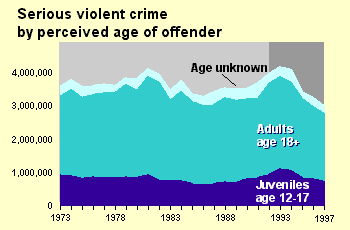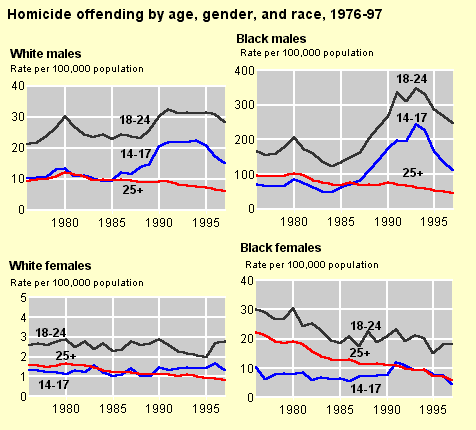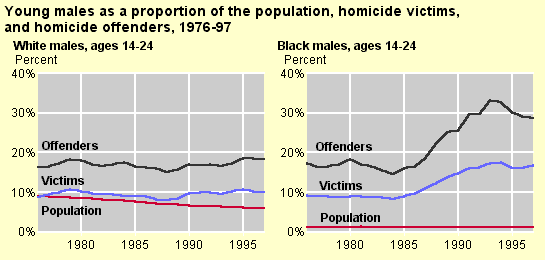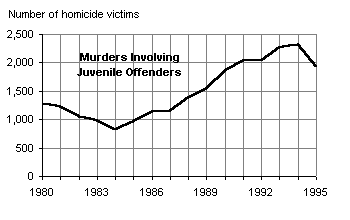|
The massacre at Columbine High in Littleton, Colorado, earlier this year put young faces on violence in America causing many talking heads to scowl and lament the epidemic of fury infecting young people today. What is the source, how is it spread, why now, why here, and what can we do about it? Obviously, the problem is too much violence on TV. Or so many say. Others spy our doom in the moral decay of western society, drugs, beer, video games, easy access to guns, racism, sexism, the foul nature of males, fast food, aspartame and fluoridated water. Who's right? Are violence on TV and violent video games turning our youth into adolescent versions of Dr. Jeckyl and Mr. Hyde? All white bread America one minute, cold blooded killers the next? Or is the problem more complex than that? Violence on TV and in movies has been around since the 40s and it did not seem to make the young of that day any more violent than previous generations. My parents, children of the Depression, grew up with Red Ryder, Captain Marvel, Edgar Rice Burrows and radio shows rife with violence, yet they seem sane. Relatively speaking, of course. So maybe it's more than just violence on TV; perhaps modern era video games are to blame. Lt. Col. Dave Grossman, co author of On Killing: The Psychological Cost of Learning to Kill in War and Society, remarks the military practice of using video game style techniques to condition reflexes appropriate to military operations. And he makes a good point. Such techniques, high tech though they are, hearken back to the earliest days of martial arts and their use of the kata. A kata is a repetitious exercise in which you go through a series of movements over and over, programming reflexes. Someone hits you, your body responds before you have time to think about it. Stimulus-response, conditioned reflexes, old as the hills now made high tech. Video games may help program those reflexes, but as Grossman has said many times on the news, it doesn't turn most kids into killers. What it does is give personalities already predisposed to violence the conditioning necessary to cross over the cultural threshold that would otherwise inhibit such behavior. What this suggests is not that we ban all video games, but rather endorse thoughtful and appropriate constraints. First, however, we need to understand precisely what the problem is, otherwise we risk running around in panic when reality begs a more deliberate approach. So what, precisely, is the problem? Not higher rates of violence
First, it is not a problem of increased juvenile violence. According to the Bureau of Justice, youth violence began declining in 1995:

Some disagree and criticize this on the basis hate crimes, including violence, are now reported separately. However, according to the FBI, there were 3,096 violent hate crimes in 1995 and if we added them back, even assuming all were committed by young people, would have made little difference in the overall rate. So if juvenile violence is actually decreasing, then what is the problem? I'm tempted to say it's the media and their insatiable need for generating attention grabbing grist that will keep us glued to their word and picture mills day after day. But it would be more productive to ask how we can assure the current trend will continue? History provides clues:What the chart below shows is a marked increase in youth violence beginning in 1979, which was a time of great turmoil. In March, the partial meltdown of one of the reactors at the Three Mile Island nuclear power plant in Harrisburg, Pennsylvania, threatened to contaminate the entire region. And by the end of the year, America went on the alert when, in November, Iranian terrorists overran the United States Embassy compound in Tehran and, with the apparent approval of the Iranian government, took the embassy personnel hostage.In 1980, America was in a recession, John Lennon was murdered and violence in all age groups peaked, then began its gradual decline until 1984, when the trend reversed.

What happened that made young Americans more prone to violence starting with those years? What extraordinary events transpired to contribute to heightened tension, greater fear, and shorter tempers? Although the years following Reagan's inauguration in 1981 were busy, Americans were buoyed by his optimism, charm and backbone. After evidently ending the Iran hostage crisis, he rebounded from an assassination attempt, cut taxes, deregulated the Savings & Loan industry, and pulled the country out of another recession. Inflation, although still high, was coming under control. In 1984, AT&T broke up and the future was ripe with opportunities. Then, the AIDS virus was identified, free love suddenly became a death threat, and Americans were knee deep in debt. In 1986 we bombed Libya, the crisis in Chernobyl reminded us of the Three Mile Island incident, and the space shuttle Challenger blew up, killing our heroes. That was also the year the insider trading scandal surrounding Ivan Boesky broke undermining national confidence as S&Ls everywhere failed in record numbers until, in October, 1987, the Dow suffered its biggest one day drop in history. And then there was the reemergence of strident and widely embraced androphobia marked by Shere Hite's ironically named condemnation of men, Women and Love. About sex?I'm not so wrapped up in gender issues as to attribute the sudden increase in the rate of youth violence at that time entirely to Hite and her fellow male-bashers, but there can be no doubt the environment was increasingly hostile toward men as the pundits put them down and authorities shut them up. And when you do that, even the pop feminists know the result is violence. As Hite herself said:
When you can't get through, after a long period of time, out of frustration, either you take it out on yourself and become suicidal, self-destructive, or you challenge the society -- and one way is to become 'terroristic.'" And if the homicide rates among boys and young men are any measure, that is precisely what happened:

No matter where we turned, everything we heard about men was bad: "all men are rapists, that's all they are" (Marilyn French), "all heterosexual sex is rape" (Robin Morgan), married women are stuck in matrimonial hell (Shere Hite), men benefit from marriage, women suffer from it (Cynthia S. Smith), boys and men are all lecherous sexual harassers (Catharine MacKinnon), "women need men like a fish needs a bicycle" (Gloria Steinem), men and boys cause all the violence in the world (June Stephenson), and so on. Had anyone attacked blacks, Jews, Indians, women or whales with such vitriol, Americans would have been up in arms. Instead, what boys heard was silence from the Right, condemnation from the Left, and muffled opposition from men's groups whose pleas for fairness and real gender equality were frequently portrayed as the last gasps of patriarchal power and white male privilege. To make matters worse, everybody knew "nice guys finish last," and on TV it was always the bad boys who got the girls, drove the cars and had the cash. What was a boy to do?What many boys did was join gangs, forming into rat packs and running wild: men were evil, boys were bad, masculinity was a crime, crime was prime time, and this they called women's liberation.The nation staggered from the crises of 1987 smack into the Exxon Valdez oil spill in 1988, the US invasion of Panama and the collapse of the Junk bond market. Meanwhile, girls embraced the new women's liberation as an invitation to behave like the worst boys. According to the FBI, the rate at which juvenile females were arrested for violent crimes has been growing faster than for males ever since 1989. And the Berlin Wall came tumbling down. The next few years were marred with violence: Desert Shield became a Storm, the L.A. Riot compelled Rodney King to beg us to "get along," and the Women's Action Coalition marched through our cities shouting, "What do we want? Safe streets! When do we want them? Now!" Men raped women, they said, men abused women and children, all men should bow in shame and commit themselves to a life time of penance for the crime of being a never-to-be sufficiently loathed male. Where could boys and young men turn for hope? For a model of masculinity that disagreed with the pop feminism without making male biology soft? Where were the stout souls to hold high the standards of fairness and face down the bigots? They were there, fighting hard but hard pressed and hard to find. Send in the clownsFive major factions of the men's/fathers' movement were aligned against the increasingly pervasive anti male bigotry, and all were treated with great disrespect by the media and derision by the pop feminists:
These great men opposed all bigotry, denied no truth, advocated fairness and equality for all, yet the media treated them like clowns, good for a laugh, a sneer, little more. Women were mad, men were bad, and political correctness ruled the day. The ladies' manPresident Clinton won by the female vote and took office in 1992 and, unlike previous administrations, he led by following. The polls, that is.He was whatever the polls said Americans wanted him to be. As Christopher Hitchens, author of No One Left to Lie To, noted, Clinton is all things to all people. Unprincipled though that is, ironically it was just what the country needed at that time. Here was a president who was seen to be listening. "Ah feel your pain," he said, and many believed him. When people think they're being heard, they act better. (In Management Theory this is known as the Hawthorne Effect, after a study in which, no matter what changes consultants made in a factory, the workers responded by working harder. It wasn't the changes that improved productivity, but the workers' perception someone was paying attention to them.) You can play that game for just so long before the effect begins to wear off, but other factors continued to mitigate against youth violence, among them the increasing visibility of the pro-fairness men's organizations due largely to our publication, The Backlash!. This may sound very egocentric, but the credit goes to the five factions listed above who did all the work. All we did was promote them, month after month putting their issues in front of politicians, producers and the press such that none could deny the allegations brought against them were lies. With information about the men's and fathers' organizations so readily available, men everywhere gravitated toward them, joining up, forming chapters, or beginning their own projects. For the first time since Betty Friedan ignited the modern feminist movement with her now increasingly discredited lash against men, The Feminine Mystique, boys and men had permission to be masculine without being violent, predatory, murderous or otherwise inherently criminal. Our leaders and even the media began to allow as how families needed fathers. And juvenile violence, though still predominantly male, began to decline for the first time in 10 years.
from 1984 to 1994 before declining in 1995. 
Top ten listAlthough most pundits have ignored how sexual politics and the rampant anti male bigotry of the late 20th century contributed to youth violence, clearly many other factors play equal if not greater roles. While many of our leaders seem prone to latch onto one or another of these as the sole cause with one simple (and career-promoting) solution, the only simple truth here is that we need to address them all if the trend in lower levels of youth violence is to continue.These include:
These ten factors, I believe, are the primary areas warranting our deliberate attention and considered action. Panic-induced policies usually do more harm than good. And although there is cause for concern, we have no reason to panic. We must remain mindful of this. There is no vast new epidemic of violence infecting our youth; indeed we should as a nation look with pride upon the generations who grew up during such turbulent times and will be our leaders in the new millennium.
|